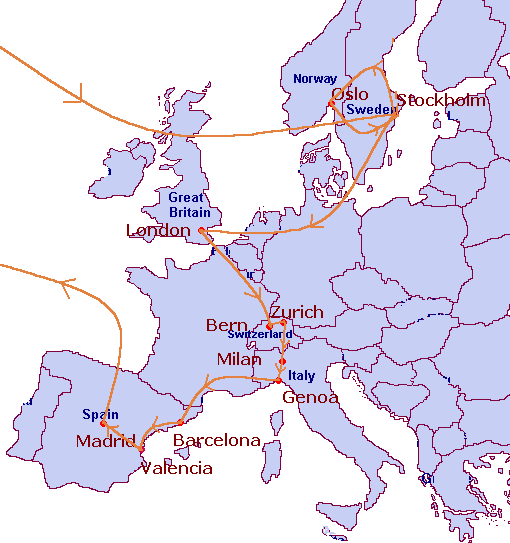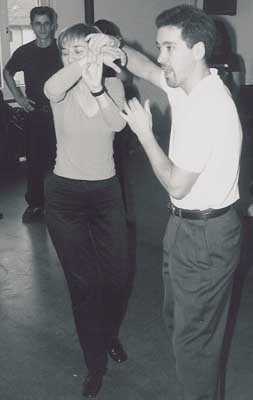Salsa Dancing in Europe
(and trying to be a tourist at the same time)

My "Europe 2000" Trip Route

My "Europe 2000" Trip Route
Can Europeans dance? - What a silly question!
I can't claim to be an expert on salsa in Europe -- I was only there for three and half months and visited six countries: Sweden, Norway, Great Britain, Switzerland, a little bit of Italy, and Spain. I went to about 30 different clubs in all the cities shown above. I taught a total of 26 workshops, and gave about 30 private lessons. People are in general very enthusiastic about salsa and are very interested in learning more. I met all sorts of nice people in the salsa scene, including a lot of hard-core salsa addicts like myself. It seems like this "salsa virus" has spread all over the world, and Europeans don't seem have any better natural resistance to the germ than North Americans do.
Clubs are everywhere, and in the cities I visited, you could go out dancing most nights of the week. Clubs were not any more expensive than in the United States. Some of them were free, some $5 and rarely were they more than about $10. The clubs came in all different sizes, and people were usually very friendly. Actually, whenever I was in a salsa club I felt like I was in familiar surroundings. It felt like I could have been in a salsa club somewhere in the United States. As is the case in the United States, the night-clubs usually have a mix of ethnicities -- people originally from the local country, latino immigrants, and other nationalities.
Just like in the United States each city has it's own style or at least flavor of a style.
From what I could tell the Colombians and even more, Cubans, set the initial style. Cuban style is, in different degrees, everywhere. The question is how much have other styles crept into the way people dance. Spain was where I saw the most pure Cuban style. London is where is saw the least. London, is where the "North American" (this is how many Europeans call it -- I would call it New York and Los Angeles styles) influences have had the most impact. In London, I hardly saw any Cuban style, and instead saw basically New York style, but "on 1."
I would say the best female dancers are in .... guess ... Stockholm, Sweden. There, they all know Cuban style (very well), and many of the better dancers also know a bit of the NY/LA stuff. I could throw out just about any move, and there were some (quite a handful) who could follow it. I can't say that about many other dancers with whom I dance with for the first time. Also, the best club I saw in all of Europe was the "Buena Vista Social Club" in Stockholm. There was a nice mix of timba (modern Cuban salsa), hard-core salsa, and little else. It was the best music I've ever heard in a club (although the music at Santa Monica Pier Boathouse in Los Angeles was amazing -- but without any timba.) The location was beautiful -- right by a river with a huge window looking out on it. I danced so much, that my back started hurting -- a new one for me! Apparently this club has changed location a few times since I've been there, so it's not exactly the same now. But, that's very common in the salsa world -- clubs, dance scenes and even dance styles, come and go.
Norway, is mostly Cuban style. Salsa is growing there rapidly and I found them to be very open to different dance styles. It will be interesting to see how the style develops over time.
flyer (front and back) for London workshops
London, I would say has the most salsa. It is everywhere. There were some spectacular dancers, and probably thousands of students learning salsa. Different people there danced different styles, including some sort of pachanga style that I haven't seen anywhere else. However, it seems to me that the dominate form among the better dancers is basically a very close hybrid of New York style, but "on 1."
 Teaching a workshop in Zurich, Switzerland
Teaching a workshop in Zurich, Switzerland 
Switzerland, I would say is the most intellectual salsa I saw. They dance very well, and analyze the dance more than anyone else I've ever come across (I think this is a reflection of their culture). I analyze the dance usually more than my students are interested in. However in Switzerland, at times, I found myself not having the detail they were looking for. I was very surprised. I'll just have to be ready for them for next time... In Bern, I got to know an instructor who has such depth and breath of knowledge of both the dance and music. He would play various songs for me, and pointed out within the music all the different influences of the piece: rhythmical, lyrical, and instrumentational influences. Not only the latin influences, but influences from different jazz eras as well. Also in Bern, I danced with a woman who left me almost speechless. She is 100% Swiss, but moved her body just like a really good Cuban "Despoletera." I don't know if she had the same intellectual approach as many of the other Swiss, but one way or another she managed to learn how to move her body about as well as anyone I've ever seen.
In Genoa, Italy, which is not a large city at all, I went to a small club and couldn't believe what I was seeing -- there were two guys dancing 100% New York style about as well as anyone in New York! In addition there were other people in the club dancing pretty well. I heard that Italy has salsa all over the country. If Genoa is any indication, then Italy must be pretty amazing for salsa.
The best city overall for salsa dancing I would say is Barcelona, Spain. There are about four clubs that often play almost 100% salsa. I visited three of them: Aqua de Luna, Buenavista, Antilla. My first night out, it was 100% salsa. Not one non-salsa played -- a first in my life. It was dancing heaven for me! I would say Barcelona had the highest average level of dancing I saw. If you were to just watch everybody dance, a large majority were dancing well. In Madrid, I basically struck out. I went to only two clubs, and didn't manage to find a club with dedicated hard-core salseros.
Have you ever heard how Spaniards stay out really late? Well, it's true! We get to the club at 11:30pm expecting that we already missed a bit. Instead, they were in middle of a pre-club dancing class. Imagine, it's almost midnight, and I find myself waiting for the music to start. Finally right after midnight, the class finishes and the music begins. At 4:00am, we left, but the dance floor was still mostly full. When do these people sleep?
Another thing I learned is that it's almost a universal rule that the worst nights for going out dancing are on Fridays and Saturdays. This seems to be true almost everywhere I go. This, of course, is from the perspective of a hard-core salsero. What I look for in a club is a lot of (good) salsa music, good dancers, and some room to dance. On Saturdays, and to a lesser degree, on Fridays, this is usually hard to find. On these days there tends to be a lot more non-salsa (merengue, house, cumbia, etc.) and a much more diluted crowd of hard-core salseros.
It is also difficult to judge how good a city is for dancing based on only going out once or twice. You could go out to the wrong club, or the right club but on the wrong night. Many people dance salsa, but the better dancers usually stick to a few clubs on a few nights. In Milan, Italy I was taken to a very popular club on a Friday night on the outskirts of the city. The club was very large, people were real dressed up (Milan is supposed to be the fashion capital of Europe, if not the world), and it was a very nice place. There were hundreds of people dancing there. I looked around but didn't see any couples that impressed me. It would have been very easy to walk away with the impression that Milan doesn't have very good dancers. But now I'm almost certain that they just weren't there that night. I also found that the average level of dancing in a city doesn't necessarily give any indication of how good the best dancers are.
How do you find the best clubs? I found that some of the information on web sites can be out of date. I believe the best approach is to try to find a local who looks for the same things as you do in dancing (in my case lots of salsa music and good dancers, etc.), and then just ask them where the best places are to go.
Anyway, I didn't see enough of Europe. There were many countries I missed, and tons more to see in each country. I'm going back! I'll teach more workshops -- in many of the same places I taught before, plus in some new places. Please contact me if you're interested.
I had debated about going during the late-fall/early-winter. Here are my conclusions about that:
Until I reached Spain (the last country on my trip), I hadn't
even spent one night in a hotel. I always stayed as a guest in the
homes of fellow salseros, and I want to thank all of them: Stina (Stockholm),
Terje, Hild, and Turid (Oslo), Barry, Paul, and Damir (London), Erich (Bern),
Oliver (Zurich), Marisa (Milan), and Fabio (Genoa). These people
(and many others) were what made my trip possible and so memorable.